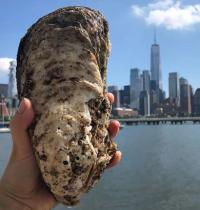
Photo: The River Project
A diver repairing Pier 40 on the Hudson River in Manhattan recently pried loose a large oyster. At 8.66 inches long and weighing in at close to two pounds, it is believed to be the largest oyster found in New York Harbor in around 100 years.
Oysters once filled New York harbor. When Henry Hudson arrived in 1609, there were some 350 square miles of oyster reefs in the New York waters, containing nearly half of the world’s oyster population. In the 19th century, New Yorkers ate roughly a million oysters every day. Oysters shells were used to pave roads and crushed into a paste for building mortar.
Overconsumption and sewage drove the harbor oysters to near extinction. Outbreaks of typhoid and cholera traced to oysters contaminated by sewage resulted in closing the last oyster beds. By 1927, the New York City oyster trade officially closed for business.
Is the big oyster found at Pier 40 a sign that oysters are returning to the harbor? Unfortunately one large oyster does not make a reef, but nevertheless, it is encouraging. Groups have been attempting to reseed oysters in New York, including the Billion Oyster Project, coordinated by the New York Harbor School with the goal of restoring one billion live oysters to New York Harbor by 2030.
Oysters are filter feeders and can dramatically help to clean harbor water. Oyster reefs can also mitigate the impact of sea level rise and storm surge erosion. It may be some time before New Yorkers are eating oysters from the harbor, however. New York City’s sewage system still overflows into the harbor whenever there are heavy rains. An estimated 20 billion gallons of mixed rainwater runoff and sewage flows into local waters annually. The good news is that this is down from 100 billion gallons in 1985, but there is still a considerable way to go.

Idiot diver should have left the oyster live, took a photo and used something (his knfe) to gage the oyster’s size.
I agree with Phil. The bigger question is why in 2018 does NY still allow 20 billion gallons of sewage and rain runoff to flow into the harbor. That’s nuts!
The repair to the pier involved water blasting the pilings and encasing them in concrete. If the oyster had not been removed it would have been destroyed, regardless.
New York like many cities had a combined sewage/runoff system. All sewage lines built after the 1950s segregate sewage and runoff. Unfortunately, most of the sewer system was built before 1950. It is not an easy problem to solve.
We have the same problem in Lorain, Ohio,
Cleveland too. Heavy rains flood storm and sewer lines and the mix.
Both Lorain and Cleveland used TBMs to dig tunnels under the cities for storm water storage. The one in Lorain is down 180-feet, 25-feet wide and just over 1-mile long, it should be finished soon.